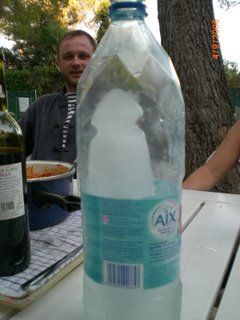In light of some recent production hiccups, specifically trouble finding suitable locations willing to let us film portions of
Women's Studies, a friend of mine chastised me for promoting the film as a straight horror movie. His argument is that by doing so, I sell the film, and by proxy myself, short by pigeonholing it. As the writer and director (a biased source if ever there was one), I concede his point. To me,
Women's Studies spans over many genres. It's a character drama, a coming of age story, and a tragic romance. It's got action and laughs as well as scares and blood.
However, the overriding emotion (if I do my job as a director right) should be one of unease and discomfort. One of my most primary goals with
Women's Studies is to simply scare the audience. That's really where I can make no concession because I
AM setting out to make a horror film. Anyone who reads the
Women's Studies script without being told what genre the film is will realize pretty quickly what they're in for. While not strictly a blood and guts type of horror film, the Karo will definitely flow heavily in the finished film.
The strange problem I've run into is despite all the talk of "mainstream" or Hollywood" horror, the genre is still a fringe genre, an acquired taste, and let's face it, the red-headed stepchild of the movie industry. Film studios, notably the big ones, don't really like making horror films. Most critics don't like them, and they don't win any awards that matter to the big dogs. Plus, though the horror move protests of the early 80s are ancient history, you still have media pundits like Bill O'Reilly spouting off about how these films represent "the degradation of the morals of America." And while I believe that kind of thinking is obnoxious and misses the point, I'm certainly not going to argue for the socially redeeming values of
Saw III.
Ah, but since I brought it up, let's take a closer look at
Saw III, the subject of O'Reilly's recent tirade, a film that was critically derided, and one unlikely to get nominated for an Oscar or a Golden Globe. However, there is one more notable aspect about the film that explains the reason why the movie industry continues it's loveless affair with the horror movie: It made a killing of money at the box office, $33 million in the first weekend alone.
Let's do the math:
Saw III was budgeted at $10 million. In it's first week of release it made it's producer, Lions Gate Films, a 300% profit. Currently, it's earned a worldwide gross of around $130 million. ($80 million domesticly and $50 million worldwide, if you want to get specific.) That's a $120 million profit which isn't taking into consideration DVD sales and rentals which make up the majority (75%) of a major studios profits. Even if you assume that the $10 million budget doubles with DVD marketing and distribution costs, that's still a film which sits firmly in the black.
(For the record, I've seen none of the
Saw movies. Laugh if you want, but I'm very squeamish, and torture movies make me want to pass out.)
So, why do big studios keep making horror movies? Simple: They even out their bottom line. As far as Lion's Gate is concerned,
Saw III's success makes up for the fact that
Employee of the Month and
Crank only made (ONLY!!!) $28 million. Actually, both films were budgeted at $12 million each and, hence, made money. Still, that's a $32 million profit from both movies combined compared to
Saw III's $120 million profit.
I'll quit beating you over the head with it. The point is that "moral degradation" or not, there's a huge audience for horror. As long as that audience is willing to keep ponying up the cash to see these movies, big studios and major filmmakers will keep making them. The producers behind the
Saw movies said before it's release that
Saw III was likely to be the last one. Keep in mind that the fourth movie in the
Friday the 13th series was subtitled, "The Final Chapter." The upcoming
Friday "re-imagining" (Don't even get me started there.) will be the twelfth film of the franchise.
But let's forget about the big studios for a minute.
Women's Studies is not being produced by a big studio. And frankly, when it comes to actually producing good horror films, big studios really aren't where the action is. Most horror films that are "studio releases" are actually produced by smaller independent film companies. (In industry terms, it's called "negative pick-up.") Recent examples include:
Hard Candy,
Wolf Creek, and what a lot of horror fans are calling the best fright flick in years,
The Descent. (Which I still haven't seen because the sad joke is that when you're trying to make a movie you don't really have time to watch them.)
Forget those even. Let's take a look at what are considered the classic horror films:
Psycho: Independently produced by Hitchcock who went outside the studio system to get it made. Paramount originally distributed it in 1960, and Universal bought up the rights for a successful late sixties re-release.
Night of the Living Dead: Independently produced by George A. Romero's Image Ten. The original distributor let the copyright expire somehow and the film entered the public domain. This also happened with
The Wizard of Oz and
It's a Wonderful Life. However, Romero claims the original distributor "ripped him off" when they didn't put a copyright notice on any prints of the film that went out. This seems sketchy to me, but copyright law was much different in 1968 than it is now. Back then, copyrights expired after 50 years instead of 95. The math doesn't quite work out though, so your guess is as good as mine. I do know that Romero only has received residuals from the 1998 Elite Media release of NOTLD. The other estimated $50 million the film has grossed since 1968 has all been pocketed by other distributors. Seriously, if you want to make some money, burn off a bunch of copies of NOTLD and sell them. It's perfectly legal. Fucked up, but true.
The Texas Chainsaw Massacre (the original 1974 version, not the remake): Independently produced by some mysterious outfit called "Vortex" which I can only assume was director Tobe Hooper's production company. It was picked up by New Line Cinema, which at the time, was a tiny distributor out of New York. The story is that the film played in limited release in San Francisco and Warren Beatty went apeshit over the brutal realism giving the film huge buzz.
Halloween: Independently produced by Trancas International who I also believe handled the original theatrical distribution. It was one of those cases where a distributor decided they wanted to go into the business of production as well. The late Moustapha Akkad was spending $300,000 a day on a big, desert war epic that ultimately tanked. When told
Halloween's entire budget would cost $300,000, he said, "What the hell?"
Friday the 13th: Independently produced by Georgetown Pictures, picked up and distributed by Paramount. Technically though, I suppose it was "studio financed." Director, Sean Cunningham, who had produced
Last House on the Left and
The Hills Have Eyes with Wes Craven, took out an ad in
Variety for a film called
Friday the 13th and billed it as "the most horrifying film ever made." The funny part is that he had no script, not even a story idea except that he wanted to rip off the success of
Halloween. Georgetown called him up the next day and offered to finance the picture.
Evil Dead: Sam Raimi himself raised the money by hitting up dentists which has since become a common low budget fundraising method. New line, which was apparently the Lion's Gate of the late 70s and early 80s, picked it up after Raimi got a glowing review by none other than Stephen King. Like Trancas, they soon turned around and moved into actual film production by making:
A Nightmare on Elm Street: I include it as independently produced because long before
Lord of the Rings, New Line didn't have a pot to piss in when they went into production on
Elm Street. They're still referred to as "The house that Freddy Krueger built."
Not one of the films I mentioned above was financed or made by a major studio, yet they're some of the most well known, and most financially successful horror films in film history. (However, it may be worth noting that the most financially, and some would argue critically, successful horror film of all time,
The Exorcist, was financed, produced and released by a major film studio, Warner Bros.)
My final point is this: Most of the successes in the horror genre have come from independent film producers like me. The reason is that we're not doing it to pump up our bottom line. We're doing it because we love the genre and we believe that these stories, as "morally degrading" as they may be, are worth telling, and more importantly worth being heard. By billing
Women's Studies as a horror film, I'm hoping to find individuals to help me get it made that are like minded, that truly support what we're trying to do. It's not necessarily an easy sell, but it's the right one.




